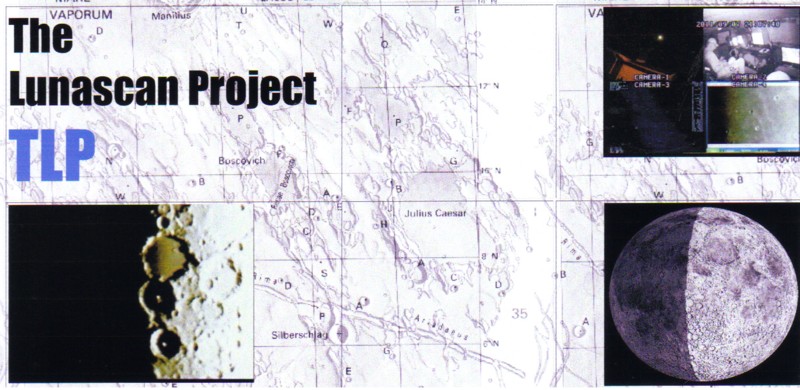
|
Updated: June 28, 2018 The Lunascan Project (TLP): Originally, was an
EBTI (Earth-Based Telescopic Imaging) project using live
CCD & CMOS technology to document and record LTPs
(Lunar Transcient Phenomena) and other anomalies
observed near the Moon. That phase of the program ended
in 2016 after almost a hundred recorded missions The Lunascan Project was established in September of
1995 and utilized a large 16" Newtonian reflector, then
later a 10" f/6. The website was created in 1997. The
Project continued with the use of an 8" Schmitt
Cassegrain, a binocular eyepiece, two computers and an
array of monitors and recorders. Previously operated
from within a building, the whole system was operated
from a van referred to as the "Moon Buggy" under the
project title, TCCM (Telescope & Crew Control
Module). Cameras provided live high, medium & low
power, high resolution television pictures of the lunar
surface. Later, the van was sold and a 6x10 trailer with
air conditioning was employed with even better
technology under the project name of LIMO (Lunar Imaging
Module & Observatory). Pages describing these
projects, along with images, can be found at the top of
the home page. In September of 1995 The Lunascan Project began with three primary goals: 1) To conduct live and recorded high-powered scans of the lunar surface in an serious long-range project to document reports of LTPs (Lunar Transient Phenomena) and FMOs (Fast-Moving Objects or "fastwalkers"). 2) To create a comprehensive computer database of LTPs, mistakenly thought to number about 200 in total, mostly anecdotal in nature with numerous drawings, and only a few with photographs. In existence already were two NASA catalogs with about 1500 reports. The lunar nearside had already been divided into 76 Sections (Rukl) so we crerated a clickable chart. The new database would simply list primary target areas by section and region. Also keyed to the database was the location of the most detailed photographs from major observatories and ID numbers of the best NASA images. 3) With the aid of others interested in scientific
research of our nearest neighbor, the isolation and
placement into proper context the nagging reports of
alien artifacts. These reports, documented by numerous
authors of numerous books, were being investigated by
several verification groups, much more capable than The
Lunascan Project and armed with the best images NASA has
in its possession (Apollo, Lunar Orbiter and Clementine
imagery). These groups pledged their assistance. In June
of 2016 we discovered strange objects in LRO images of
the lunar far side. 4) Strange objects observed possibly NEAR the Moon,
"FMOs" ("Fast-Moving Objects") or "Fastwalkers" were
also being reported. These were seen on more rare
occasions and were easily observed and recorded at lower
powers. 5) Meteorite impacts on the dark side. 6) In 2013 we set up a new clickable chart for the
lunar Far Side and began research on the most mysterious
and interesting part of the Moon. Project Far Side has a
goal of filling its 87 directories by the end of 2014. In order to launch the Lunascan Project dream, which was conceived in the 1970's, it became necessary to solicit support and investment capital from several individuals. A newsletter (Lunascan Update) was circulated until we created The Lunascan Project web site, to discuss the research and report the findings. The supporters and members of the project have their feet on the ground and their eyes on the stars, and in particular, the Moon. With every discovery there are new mysteries and questions. The Moon may not be a dead world as once thought. There remains a lot to be learned. If the Project accomplishes nothing more than serious documented LTP research, it will be considered a resounding success. Just a little more than a year into the Project, The
Lunascan Project team videotaped an object which
appeared to be orbiting the Moon. (See U092196). The best is yet to come. Stay tuned. The best way is to
read the Message from the Project Director on the home
page. Francis L. Ridge, |